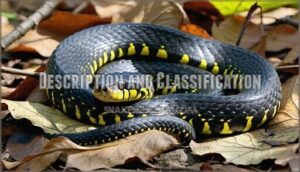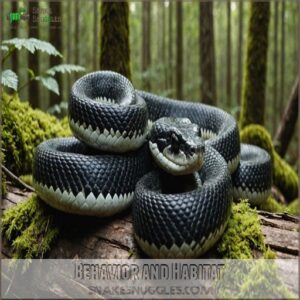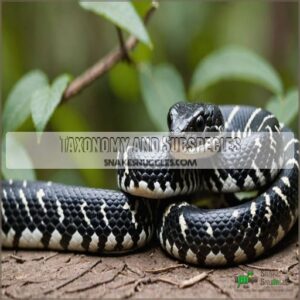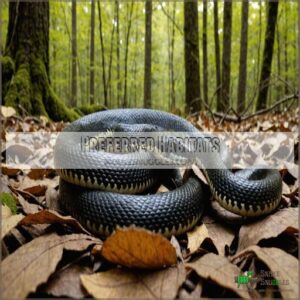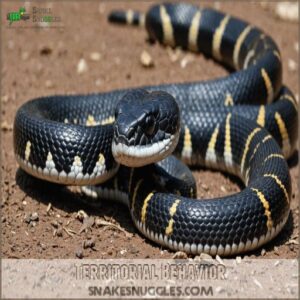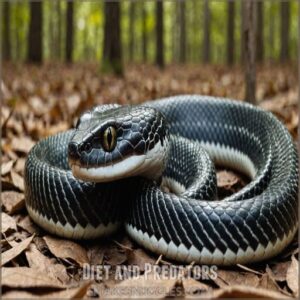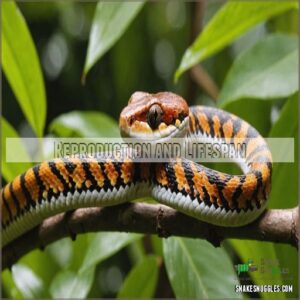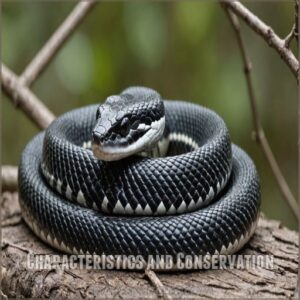This site is supported by our readers. We may earn a commission, at no cost to you, if you purchase through links.
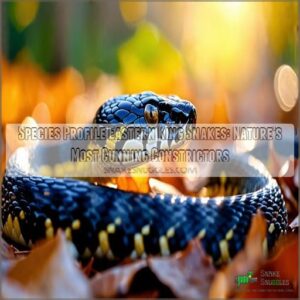
These non-venomous constrictors sport a stunning black coat decorated with white or yellow chain-like bands.
They’re immune to other snakes’ venom and won’t hesitate to make a meal of copperheads or rattlesnakes.
Growing up to 7 feet long, they’re impressive but gentle giants that prefer to spend their days hunting in forest edges and wetlands.
While they’re excellent climbers, you’re more likely to spot them prowling through leaf litter, where they keep local rodent populations in check.
Table Of Contents
- Key Takeaways
- Description and Classification
- Habitat and Distribution
- Diet and Predators
- Reproduction and Lifespan
- Characteristics and Conservation
- Frequently Asked Questions (FAQs)
- Where are Eastern king snakes found?
- What is an eastern King Snake?
- Is a kingsnake a colubrid species?
- What is a common King Snake?
- What are the characteristics of the eastern kingsnake?
- Are Eastern king snakes harmful?
- What is unique about the king snake?
- What is the difference between eastern kingsnake and Florida kingsnake?
- How dangerous are eastern kingsnakes to humans?
- Can eastern kingsnakes be kept as pets?
- What sounds do eastern kingsnakes make?
- How fast can eastern kingsnakes travel?
- Do eastern kingsnakes hibernate during winter months?
- Conclusion
Key Takeaways
- You’ll find eastern kingsnakes are non-venomous constrictors with distinctive black bodies marked by yellow or white chain-link bands, typically growing 36-42 inches long.
- They’re immune to other snakes’ venom and won’t hesitate to prey on venomous snakes like copperheads and rattlesnakes, making them natural snake-control specialists.
- You can spot them across 27 U.S. states from New Jersey to Arizona, preferring habitats with dense shrubs and thick leaf litter where they hunt during daylight hours.
- They’ll live up to 25 years, lay 3-24 eggs per clutch, and while they’re skilled predators, they face threats from habitat destruction, road mortality, and predators like hawks and raccoons.
Description and Classification
You’ll find the eastern kingsnake to be a smooth-scaled, non-venomous snake with a striking black body marked by yellow or white chain-link bands.
If you’re lucky enough to spot one in the wild, you’ll notice it’s a medium-sized snake typically measuring 36-42 inches long, with a short head and small, beady eyes that give it an unmistakable appearance.
Physical Characteristics
You’ll spot an eastern kingsnake by its striking appearance – a glossy black or dark brown body adorned with vibrant yellow or white chain-link bands.
These magnificent creatures typically stretch 36-42 inches long, with a robust build weighing between 10 to 80 ounces.
Their distinctive features include a short, stout head, beady eyes, and smooth scales that give them their characteristic shine.
Behavior and Habitat
Like shadow-dwelling ninjas, eastern kingsnakes move stealthily through diverse habitats, from open grasslands to dense woodlands.
You’ll find them most active during daylight hours from May to October, though they’ll switch to nighttime hunting when temperatures soar.
Eastern kingsnakes exhibit unique patterns of kingsnake behavior.
They’re masters at finding cozy spots under rocks, logs, and leaf litter, where they can stay hidden from predators while keeping an eye on potential prey.
Taxonomy and Subspecies
Eastern kingsnakes belong to the family Colubridae, with seven distinct subspecies that showcase nature’s incredible diversity.
You’ll find variations like the Brooks’ kingsnake with its bold patterns, the sleek Florida kingsnake, and the striking Mexican black kingsnake.
Each subspecies has adapted to its local environment, developing unique characteristics while maintaining the species’ core traits of being excellent constrictors and immune to venom.
Habitat and Distribution
You’ll find eastern kingsnakes across an impressive range of habitats, from the grasslands of Arizona to the oak woodlands of Virginia and even in parts of northern Mexico.
While they can adapt to various environments, you’re most likely to spot them in areas with dense shrubs and thick leaf litter, which provide perfect hiding spots for these skilled hunters.
Geographic Range
From coast to coast, these remarkable snakes have carved out a vast territory across North America.
You’ll find them in 27 U.S. states, stretching from New Jersey to Arizona and from Iowa to Florida.
They’ve even become world travelers, establishing introduced populations in Gran Canaria.
As climate change shifts their boundaries, these adaptable reptiles continue to expand their range, particularly in urban areas.
Preferred Habitats
Three distinct landscapes shape the kingsnake’s preferred home: open grasslands, dense woodlands, and riparian zones.
You’ll find these adaptable serpents thriving where thick leaf litter meets dense shrubbery, creating perfect microclimates for both shelter and hunting.
Whether it’s abandoned farms or low mountain slopes, they’ve mastered survival across diverse elevations.
They’re particularly fond of areas where human activity hasn’t drastically altered the natural landscape.
Territorial Behavior
Male kingsnakes aren’t just territorial – they’re fiercely protective of their home turf.
You’ll find them engaging in intense combat with other males, especially during breeding season.
These battles aren’t just for show; they’re testing each other’s strength through intertwined wrestling matches.
When defending their space, they’ll employ various strategies, from tail-rattling displays to aggressive posturing, ensuring their territory remains exclusively theirs.
Diet and Predators
You’ll find that eastern kingsnakes aren’t picky eaters, as they’ll consume everything from venomous snakes and small mammals to bird eggs and lizards.
While they’re skilled hunters, these snakes aren’t at the top of the food chain, as they face threats from predators like hawks, raccoons, and even other snakes.
Prey and Immunity
Snake-eating champions, eastern kingsnakes have evolved remarkable immunity against venomous prey, a trait shared by other animals that are immune to snake venom, such as woodrats and opossums.
You’ll find these skilled hunters tackling everything from rattlesnakes to copperheads without breaking a sweat.
Their specialized blood proteins neutralize venom, making them virtually unstoppable predators.
- They constrict their prey, including venomous snakes, with powerful muscles
- Their diet includes bird eggs, small mammals, and lizards
- They possess unique proteins that bind to and neutralize snake venom
Predators and Threats
Despite their impressive hunting skills, eastern kingsnakes face their own set of predators in the wild.
You’ll find them dodging attacks from badgers, raccoons, and keen-eyed roadrunners.
Hawks pose a significant threat from above, while other snake species may turn the tables on these usually dominant predators.
Human activities, particularly habitat destruction and road mortality, have become increasingly significant threats to their survival.
Unique Hunting Behavior
Eastern kingsnakes are master hunters with a remarkable trick up their scales – they’re immune to the venom of their prey.
You’ll find them using their powerful muscles to constrict victims up to 1.5 times their size.
They’ll track prey using both sight and smell, striking with precision before coiling tightly around their catch.
Their unique hunting strategy includes specialized jaw muscles that help them swallow prey whole.
Reproduction and Lifespan
You’ll find eastern kingsnakes’ breeding habits fascinating, as females lay up to several dozen eggs that hatch within two and a half months.
You might be surprised to learn that these remarkable reptiles can live for 25 years or more, making them one of the longer-lived species among North American snakes.
Mating and Breeding
Kingsnakes showcase fascinating mating behaviors during spring’s warmer days.
Like skilled dancers at nature’s ball, these serpents engage in an intricate courtship ritual.
Check out products related to Eastern King Snake Mating.
Here’s what you’ll witness during their dating game:
- Males track females using scent trails
- Rivals engage in combat, wrapping around each other
- Winners perform rhythmic body waves near females
- Both snakes intertwine in a breeding dance
- Males use gentle neck-biting to secure position
Egg-Laying and Incubation
After successful mating, female kingsnakes seek out protected spots like hollow logs or underground burrows to lay their eggs.
You’ll find they deposit clutches of 3-24 eggs in these carefully chosen locations.
The eggs need about 60-75 days to develop, maintaining a steady temperature of 80-85°F.
When the time’s right, tiny snakes measuring 8-11 inches emerge, ready to tackle the world.
Lifespan and Longevity
Anyone curious about these remarkable reptiles will be interested to know they’re among the longer-living snake species.
You’ll find that eastern kingsnakes typically live 25 years or more in captivity, though their wild lifespan can vary greatly.
Their longevity depends on several factors, including habitat quality, food availability, and predator presence.
With proper care in captivity, they’ve been known to reach impressive ages beyond 30 years.
Characteristics and Conservation
You’ll find that eastern kingsnakes stand out with their striking chain-link patterns and impressive hunting abilities, making them one of nature’s most effective predators.
As you learn more about these remarkable constrictors, you’ll discover they’re facing increasing habitat loss and fragmentation, which presents challenges for their long-term survival.
Unique Features and Adaptations
These remarkable reptiles have evolved some fascinating adaptations.
You’ll notice their venom immunity lets them tackle dangerous prey like rattlesnakes, while their powerful constricting abilities make short work of their meals.
When threatened, they’ll put on quite a show, rattling their tails like a rattlesnake and releasing musk to deter predators.
Their distinctive wide bands serve as both camouflage and warning signals.
Comparison With Other Species
Eastern kingsnakes share several traits with their close relatives, but they’re unique in their ability to conquer venomous snakes.
While California kingsnakes prefer mainly rodents, eastern kingsnakes aren’t picky – they’ll tackle everything from copperheads to coral snakes.
You’ll notice they’re generally larger than rat snakes but smaller than indigo snakes, with distinctive chain-like patterns that set them apart from their cousins.
Check out a detailed king snake comparison to better understand their characteristics.
Conservation Status and Threats
While kingsnakes remain relatively common across their range, they face mounting pressures from habitat loss and road mortality, including the loss of their preferred open areas like grasslands, deserts, and riparian zones favored habitats.
You’ll find these resilient reptiles adapting to urban edges, but climate change and invasive species pose growing challenges.
Human interaction, particularly collection for the pet trade, adds another layer of stress.
Despite these threats, their adaptability and wide distribution help maintain stable populations in many areas.
Frequently Asked Questions (FAQs)
Where are Eastern king snakes found?
You’ll find these impressive snakes throughout much of the United States, from New Jersey to Florida and west to Arizona.
They’re also present in northern Mexico.
They have been introduced to Gran Canaria in the Canary Islands.
What is an eastern King Snake?
Like a living chain of gold on black velvet, the non-venomous eastern king snake sports distinctive yellow bands on its dark body.
You’ll find these powerful constrictors immune to venom and capable of eating other snakes.
Is a kingsnake a colubrid species?
Yes, the kingsnake is definitely a colubrid species.
They’re members of the Colubridae family, which is the largest snake family.
You’ll find these non-venomous snakes are known for their distinctive chain-like patterns.
What is a common King Snake?
The Eastern Kingsnake, a non-venomous colubrid, is nature’s snake hunter.
They’re known for their striking black scales with white or yellow chain-like bands.
They also have an impressive ability to eat other snakes, including venomous ones.
What are the characteristics of the eastern kingsnake?
Eastern kingsnakes showcase a striking black body with yellow or white chain-link bands.
You’ll find they’re non-venomous constrictors reaching 36-42 inches long, immune to venom, and expertly hunt other snakes, including venomous ones.
Are Eastern king snakes harmful?
Despite their intimidating name, you’ll be glad to know king snakes are harmless to humans – they’re non-venomous and actually help by eating venomous snakes!
They’re shy and typically flee rather than confront people.
What is unique about the king snake?
You’ll find king snakes fascinating because they’re immune to other snakes’ venom and can eat them safely.
They’re also great constrictors that sport distinctive chain-link patterns.
King snakes help control venomous snake populations.
What is the difference between eastern kingsnake and Florida kingsnake?
While both snakes share similar black coloring, Florida kingsnakes display wider, more vibrant yellow bands and typically grow larger than their eastern cousins.
They’re also found exclusively in Florida’s peninsula region.
How dangerous are eastern kingsnakes to humans?
Eastern kingsnakes are non-venomous and generally harmless to humans.
They don’t actively seek confrontation and will try to flee when encountered.
If handled roughly, they might bite defensively, but it’s not dangerous.
Can eastern kingsnakes be kept as pets?
As gentle as a garden breeze, these docile serpents make fantastic pets.
You’ll find them easy to handle, relatively low-maintenance, and perfect for beginners.
They’re legal in most states with proper permits.
What sounds do eastern kingsnakes make?
You’ll rarely hear sounds from these quiet reptiles.
They can’t vocalize, but when threatened, they’ll vibrate their tails against leaves or debris to create a rattling sound, similar to a rattlesnake’s warning.
How fast can eastern kingsnakes travel?
While they’re typically calm movers, these snakes can zip along at speeds up to 4 mph when they need to.
They’ll find them moving faster in warm weather, especially when they’re hunting or escaping danger.
Do eastern kingsnakes hibernate during winter months?
Eastern kingsnakes don’t truly hibernate but enter brumation during winter months. They’ll find shelter underground or in logs, lowering their metabolism and activity levels until warmer temperatures return in spring.
Conclusion
Consider Sarah’s experience: after finding an eastern kingsnake in her garden, she learned to appreciate these remarkable reptiles.
Whether you’re a wildlife enthusiast or casual observer, understanding these species profile eastern king snakes reveals their important role in our ecosystem.
They’re more than just snake-eating experts; they’re living proof of nature’s ingenious designs.
By protecting their habitats and spreading awareness, we’re ensuring these beneficial constrictors continue to thrive for generations to come.

